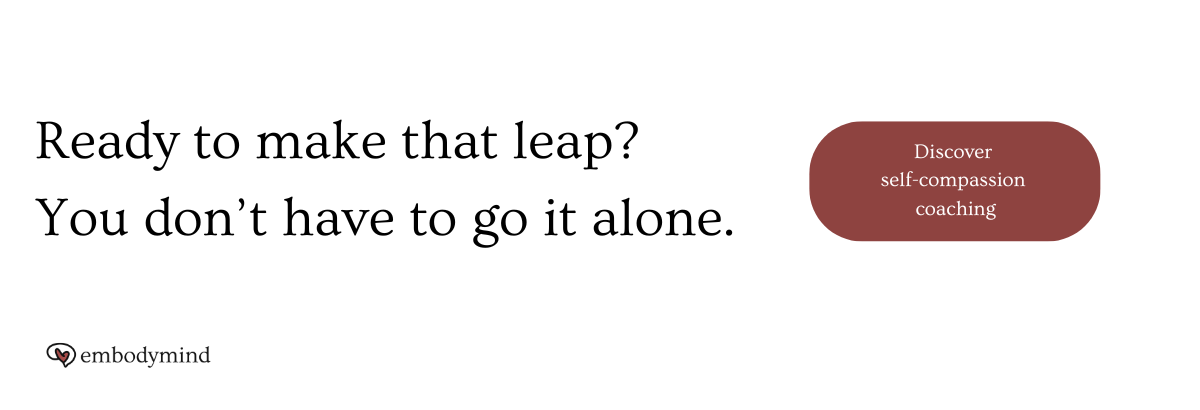Why change is hard (and how self-compassion makes it easier)
A tale of collapse, courage, and healing through the transformational power of inner kindness.
My healing journey started on a beautiful early spring day, high in the snowy mountains of southeastern BC.
We were nearing the top of our climb after our first snowboard run when my legs faltered. My mouth felt like sandpaper, and every ounce of energy evaporated. It took all I had in me just to haul myself back to the car.
My body, already stressed from a history of trauma and chronic illness, had finally said “enough.” In the weeks to come, it went into full-scale revolt. My mind followed shortly after, as I spiralled into severe anxiety and depression.
What I didn’t know then was that this breakdown would become my catalyst for real change.
Looking back, it had been brewing for a while. The COVID-19 pandemic had me locked down and living in constant fear of the virus. A few months earlier, I’d suddenly lost my high-stress tech job. Turning 40 had me primed for a midlife crisis, which added more fuel to the fire.
This wasn’t my first rodeo with a mental health crisis. But in the past, I was single. When things went south in my psyche, the impact landed largely on me.
This time around, it was agonizing to watch it affect my kids. To see how it ripped at loose seams in my marriage.
When I finally got my feet back under me, I vowed it would be the last time I went through something like this.
I was ready for transformation. But up to this point, it had been hard to come by.
The safety of the familiar
Looking back, I’m not surprised it took such a difficult experience to set the stage for change.
Even if we’re highly motivated and working hard to shift unhelpful habits, patterns, and trauma responses, it can be hard to do.
That’s because, along with effort and perseverance, change requires a hefty dollop of courage.
Transformation involves questioning and shifting our identity—who we believe ourselves to be. Even if said identity is painful, it gives us a sense of safety. So, while we crave a new way of being, we instinctively cling to what feels stable.
So change is like stepping off a solid but uncomfortable cliff ledge into an unknown but beckoning void.
What’s more, the prospect of even considering stepping into that unknown can be scary.
When we try to form new habits or ways of being, it’s natural to hope we’ll succeed. That hope involves a risk that we’ll fail. The prospect of failure can feel so crushing that it keeps us from even peeking over the edge.
So, our resistance isn’t a reflection of our laziness, weakness, or other perceived failings. It’s a built-in protection mechanism.
My first tries at real change
My growth process started about half a decade before that day in the mountains, soon after my wife and I had our first child.
Anxiety and mood challenges were lifelong companions. But my coping strategies helped me survive long enough to reproduce.
But then I saw how my moods and behaviour were impacting our sweet two-year-old girl.
I was often edgy and reactive. I struggled to find joy in the places it was most available to me. I wasn’t present or able to be the father and partner I wanted to be.
The only tool in my belt to deal with it was to escape on risky or exhausting adventures (see above). They helped in the short term but weren’t sustainable.
I knew there had to be a better way. So I went to see a therapist for the first time.
My therapy journey lasted several years and was helpful. It gave me a safe relational space to explore my trauma story and have it received with empathy. It also helped me understand the origins of my struggles. And I got some tools to help mitigate their impacts on my life.
I gained some perspective and made some tweaks to my life that took the edge off my suffering.
But the real change I needed—the deep, cycle-breaking healing—seemed impossible.
Standing on the edge of transformation
I know how hard it can be to long for change that feels unachievable. And the suffering of trying and failing.
We start a diet, only to find ourselves huddled in the corner with a bucket of ice cream and a spoon after a tough day.
That commitment to exercising more? We can’t quite get there and feel self-loathing when we spend the afternoon binge-watching Netflix.
Leaving the therapist’s office, we feel like a million bucks, only to stumble back into the same painful pattern several hours later.
Spoiler Alert: Real change doesn’t come from trying harder. It starts with safety.
We feel motivated. We try our best to persevere. We can see the edge of that ledge. We might inch closer to it. But we keep retreating to our safe place again.
So, this begs the question: How can we make true change happen?
Spoiler Alert: Real change doesn’t come from trying harder. It starts with safety.
The paradox of change
Carl Rogers, founder of Person-Centered Therapy, famously described the paradox of change when he said: “When I accept myself as I am, then I can change.”
Self-acceptance involves learning to see ourselves clearly and not rejecting what we see. We can only grow when we feel unconditionally accepted. This lets us drop our defenses and opens the door to transformation.
When we consider this from the perspective of protection and safety, it makes perfect sense.
Self-acceptance tells our most-defended parts that they don’t need to fear. We see them and accept them for who they are. That safety helps them soften and become more open to the prospect of change.
Learning to accept ourselves opens us up to the possibility of making that leap into the unknown. It lets us stand up, walk to the edge of that ledge, and peer over it to see what’s beyond.
Self-compassion gives us wings
If change involves a leap into the unknown, self-compassion gives us wings. It let us soar into that future we’ve dreamed of for so long.
Self-acceptance says, “I see myself clearly and I won’t reject what I see.” Self-compassion takes it a step further with, “I’ve got my own back—no matter what.”
It lets us know that whatever happens, we’ll meet ourselves with kindness rather than condemnation.
This imbues us with the resilience we need to make the difficult journey from present state to future self.
We can stand at the precipice of change with the knowledge that when we make that leap—no matter what foul weather blows through on our journey—we can stay aloft.
When my real healing started
When things fell apart during the pandemic, I got pushed to the edge of my ledge.
The pain of staying the same was finally greater than the discomfort of transformation.
The pain of staying the same was finally greater than the discomfort of transformation.
I was ready for true change.
My radical inner shift started with a Mindfulness-Based Stress Reduction workshop. It was a different approach to meditation than I’d ever experienced before that opened the door to developing a regular mindfulness practice.
Through MBSR, I discovered Insight Meditation. The Insight teachings showed me a new way of relating to my inner life—my thoughts, feelings, and bodily sensations.
It’s also where I learned the practice of self-compassion; of meeting that inner experience with deep kindness when things are difficult.
In discovering and doing these practices, I planted the seeds of true change.
I could see my inner experience clearly, without judging or rejecting it. If what I experienced was painful or difficult, instead of pushing it down or acting it out, I could meet it with kindness.
In other words, I learned to accept myself and have my own back. No matter what.
Many other humans, practices, and medicines helped me heal. But mindfulness and self-compassion were the threads that bound it all together.
Someone to walk beside you
When I truly changed, I could feel the positive impact it made on my life. Then I started noticing more comfortable ledges in my life—and actively leaping into the unknown in search of more growth.
Looking over those ledges can still be scary. It’s a strange mix of fear and limitless potential.
I stand at the precipice, notice my breath, and remember that what’s beyond the edge is a new way of being in the world that feels better: More safety in my body. Greater authenticity. The ability to truly share what’s in my heart and on my mind.
That’s what self-compassion has given me: The steadiness to stay when it’s uncomfortable. The courage to leap when I’m ready. And the trust that even if I stumble, I’ll meet myself with kindness, brush off the dust and keep moving forward on my path.
And, when things feel really uncomfortable and I’m hesitant to shift, I have people I can reach out to for support. Self-kindness tells me I don’t have to go it alone.
If you’re standing at your own ledge—tired of repeating old patterns, ready for lasting change—you don’t have to leap alone.
I now walk beside change seekers as they learn to listen inwardly, soften resistance, and find their footing in the unknown.
If this resonates, you can learn more at embodymind.co, or reach out at info@embodymind.co





